
The common buzzard is a medium-to-large bird of prey which has a large range. It is a member of the genus Buteo in the family Accipitridae. The species lives in most of Europe and extends its breeding range across much of the Palearctic as far as northwestern China, far western Siberia and northwestern Mongolia. Over much of its range, it is a year-round resident. However, buzzards from the colder parts of the Northern Hemisphere as well as those that breed in the eastern part of their range typically migrate south for the northern winter, many journeying as far as South Africa.

Dacrydium cupressinum, commonly known as rimu, is a large evergreen coniferous tree endemic to the forests of New Zealand. It is a member of the southern conifer group, the podocarps.

Bonelli's eagle is a large bird of prey. The common name of the bird commemorates the Italian ornithologist and collector Franco Andrea Bonelli. Bonelli is credited with gathering the type specimen, most likely from an exploration of Sardinia. Some antiquated texts also refer to this species as the crestless hawk-eagle. Like all eagles, Bonelli's eagle belongs to the family Accipitridae. Its feathered legs marked it as member of the Aquilinae or booted eagle subfamily. This species breeds from Southern Europe, Africa on the montane perimeter of the Sahara Desert and across the Indian Subcontinent to Indonesia. In Eurasia, this species may be found as far west as Portugal and as far east as southeastern China and Thailand. It is usually a resident breeder. Bonelli's eagle is often found in hilly or mountainous habitats, with rocky walls or crags, from sea level to 1,500 m (4,900 ft). Habitats are often open to wooded land and can occur in arid to semi-moist climate. This eagle, though it can be considered partially opportunistic, is something of a specialist predator of certain birds and mammals, especially rabbits, galliforms and pigeons. On evidence, when staple prey populations decline or are locally scarce, Bonelli's eagle switch to being an opportunistic predator of a wide variety of birds. Despite its persistence over a large range and its continued classification as a least concern species by the IUCN, Bonelli's eagle has declined precipitously in various parts of its range, including almost all of its European distribution, and may face potential local extinction. The species' declines are due to widespread habitat destruction, electrocution from electricity pylons as well as persistent persecution.

A shoe size is an indication of the fitting size of a shoe for a person.

Bibionidae is a family of flies (Diptera) containing approximately 650–700 species worldwide. Adults are nectar feeders and emerge in numbers in spring. Because of the likelihood of adults flies being found in copula, they have earned colloquial names such as "love bugs" or "honeymoon flies".

Syritta pipiens, sometimes called the thick-legged hoverfly, is one of the most common species in the insect family Syrphidae. This fly originates from Europe and is currently distributed across Eurasia and North America. They are fast and nimble fliers, and their larvae are found in wet, rotting organic matter such as garden compost, manure, and silage. The species is also commonly found in human-created environments such as most farmland, gardens, and urban parks, wherever there are flowers. This species is an important part of its native ecosystem as adult Syritta pipiens flies are critical pollinators for a variety of flowering plants and the species supports parasitism by various parasitic wasp species. Thus, they play an important role in environmental functionality, and can serve as bio-indicators, in which their abundance can reflect the health of the environment. Syritta pipiens looks like many predatory hoverfly species, yet is not predatory.

Prochoreutis myllerana, Miller’s nettle-tap or small metal-mark, is a moth of the family Choreutidae found in Asia and Europe. Miller's nettle-tap was first described by Johan Christian Fabricius in 1794 from a specimen found in Sweden.
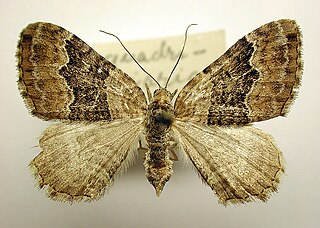
Xanthorhoe quadrifasiata, the large twin-spot carpet, is a moth of the family Geometridae. It is found in most of Europe, east to the Near East and the eastern part of the Palearctic realm.

Ancylis upupana is a moth of the family Tortricidae. It is found in most of Europe, east to Russia and China.
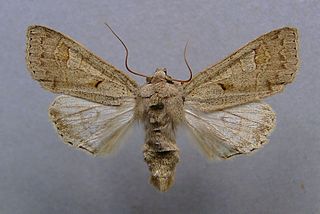
Ammoconia caecimacula is a moth belonging to the family Noctuidae. It is found in most of Europe, excluding regions such as southern Spain, Great Britain, Ireland and northern Fennoscandia. Additionally, it can be found in Anatolia, western Turkestan and across the Palaearctic to Siberia. In the east the species is represented by subspecies transcaucasica and sibirica.

Notodonta tritophus, the three-humped prominent, is a moth of the family Notodontidae. The species was first described by Michael Denis and Ignaz Schiffermüller in 1775. It is found in most of Europe, east to the Caucasus and Armenia.

Eteobalea anonymella is a moth in the family Cosmopterigidae. It is found in most of Europe, except the Benelux, Great Britain, Ireland, Iceland, Norway and Denmark.

Agonopterix astrantiae is a moth of the family Depressariidae. It is found in most of Europe, except the Iberian Peninsula, most of the Balkan Peninsula and the Benelux.

Agonopterix laterella is a moth of the family Depressariidae. It is found in most of Europe.
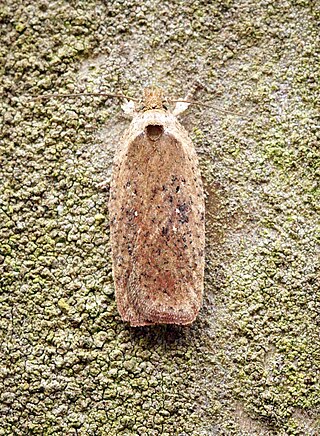
Agonopterix scopariella is a moth of the family Depressariidae. It is found in most of Europe, except Ireland, most of the Balkan Peninsula, Ukraine, Finland and the Baltic region.
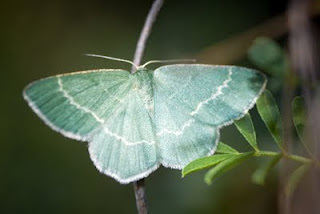
Chlorissa cloraria, the southern grass emerald, is a species of moth in the family Geometridae. It is found in most of Europe, except Ireland, Great Britain, the Netherlands, Denmark and northern Russia.

Glyphipterix bergstraesserella is a moth of the family Glyphipterigidae. It is found in most of Europe, except Ireland, Great Britain, the Netherlands, Portugal, most of the Balkan Peninsula and Ukraine.
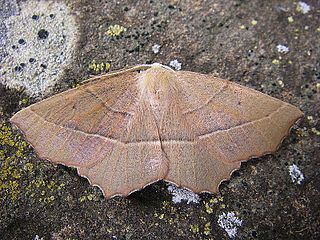
Campaea honoraria, the embellished thorn, is a species of moth in the family Geometridae. It is found in most of southern and central Europe. The species was first described by Michael Denis and Ignaz Schiffermüller in 1775.

The Eurasian goshawk is a species of medium-large bird of prey in the family Accipitridae, a family which also includes other extant diurnal raptors, such as eagles, buzzards and harriers. As a species in the genus Accipiter, the goshawk is often considered a "true hawk". The scientific name is Latin; Accipiter is "hawk", from accipere, "to grasp", and gentilis is "noble" or "gentle" because in the Middle Ages only the nobility were permitted to fly goshawks for falconry.

Notocelia tetragonana, the square-spot bell, is a species of moth of the family Tortricidae. It is found in China, Russia and Europe, where it has been recorded from most of the continent, except the Iberian Peninsula, the Netherlands, Denmark and most of the Balkan Peninsula. The habitat consists of woodland and scrubland.





















